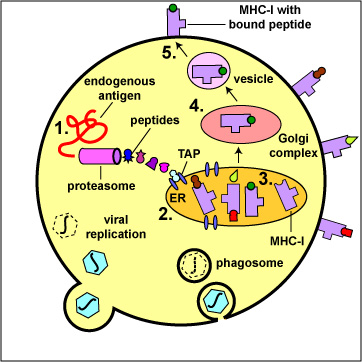
Endogenous antigens are those located within the cytosol of cells of the body. Examples include:
a. viral proteins produced during viral replication,
b. proteins produced by intracellular bacteria such as Rickettsias and Chlamydias during their replication,
c. proteins that have escaped into the cytosol from the phagosome of phagocytes such as antigen-presenting cells
d. tumor antigens produced by cancer cells,
e. and self peptides from human cell proteins.
The body marks infected cells and tumor cells for destruction by placing peptide epitopes from these endogenous antigens on their surface by way of MHC-I molecules. Cytotoxic T-lymphocytes (CTLs) are then able to recognize peptide/MHC-I complexes by means of their T-cell receptors (TCRs) and CD8 molecules and kill the cells to which they bind.
1. Endogenous antigens, such as viral proteins, pass through proteasomes where they are degraded into a series of peptides.
2. The peptides are transported into the rough endoplasmic reticulum (ER) by a transporter protein called TAP.
3. The peptides then bind to the grooves of newly synthesized MHC-I molecules.
4. The endoplasmic reticulum transports the MHC-I molecules with bound peptides to the Golgi complex.
5. The Golgi complex, in turn, transports the MHC-I/peptide complexes by way of an exocytic vesicle to the cytoplasmic membrane where they become anchored. Here, the peptide and MHC-I/peptide complexes can be recognized by CTLs by way of TCRs and CD8 molecules having a complementary shape.
Last updated: August, 2019
Please send comments and inquiries to Dr.
Gary Kaiser